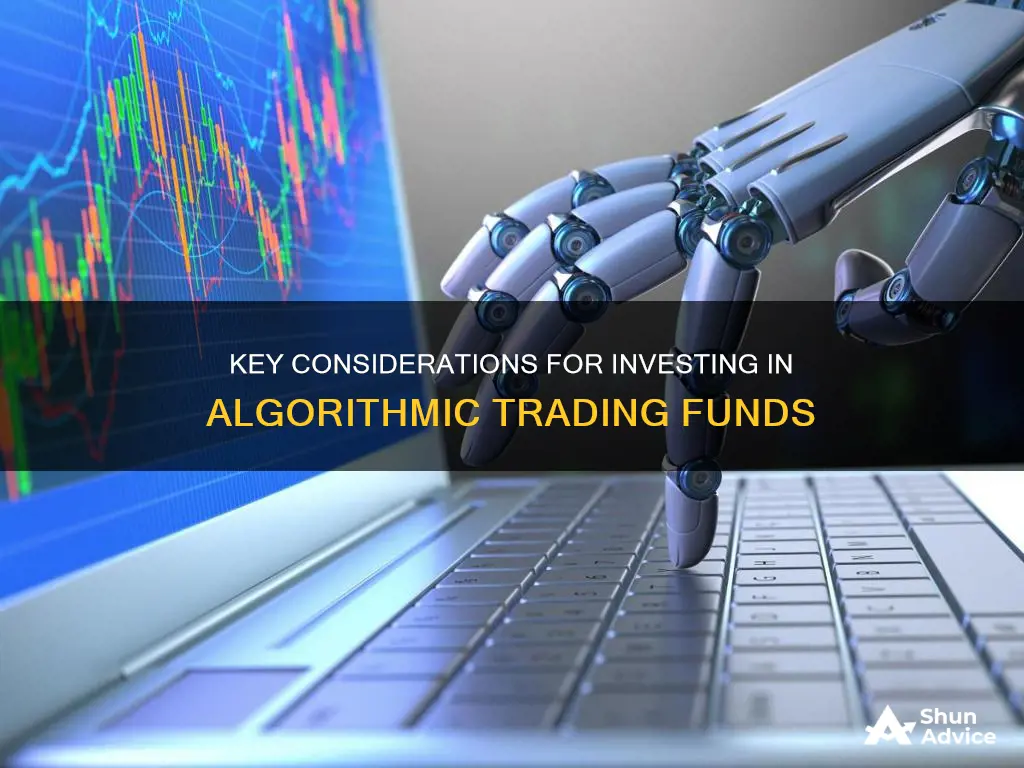
Algorithmic trading is the automated purchase or sale of stocks and other investment assets. It uses computer programs to automate the process of trading financial instruments such as stocks, currencies, and cryptocurrencies.
Before investing in an algorithmic trading fund, it is important to understand the process and the tools used for analysis, formulation, and implementation of strategies. Here are some key things to know:
- Data is crucial: Access to current and historical data for the respective segments of the exchange is essential. This data is provided by exchanges and distributed by authorized data vendors.
- Choose the right tools: Select an algorithmic trading platform that suits your trading style, features, and pricing. Some popular platforms include eSignal and MetaStock.
- Programming knowledge: Sound programming skills are vital for algorithmic trading. Languages such as Python, Java, and MATLAB are commonly used for developing trading strategies.
- Select a reliable broker: Consider factors such as the speed and reliability of the trading platform, leverage, margin requirements, compatibility with charting software, and the APIs offered by the broker.
- Updated computer system: A high-end desktop system with multiple monitors is recommended for algorithmic trading to handle the demands of multitasking and data processing.
| Characteristics | Values |
|---|---|
| Definition | Algorithmic trading is the purchase or sale of stocks and other types of investment assets via automated electronic order. |
| Synonyms | Automated trading, algo-trading, black-box trading |
| Advantages | Trades are often executed at the best possible prices; low transaction costs; no human error; reduced risk of manual errors; not influenced by human emotions; can be backtested |
| Disadvantages | High capital costs; latency issues; dependence on technology; market impact; regulation issues; limited customisation; lack of human judgment |
| Common strategies | Trend-following; arbitrage opportunities; index fund rebalancing; mathematical model-based; trading range; volume-weighted average price; time-weighted average price |
| Users | Investment banks; pension funds; mutual funds; hedge funds; private traders |
| Prerequisites | Data access; updated computer system; programming knowledge; right broker; API knowledge |
What You'll Learn

Know the type of data you need and where to get it from
Before investing in an algorithmic trading fund, it is important to understand the type of data that is required to drive these strategies and where to source it from.
Algorithmic trading strategies are underpinned by mathematical models and historical data. These models are designed to identify patterns and trends in the market and make trading decisions based on this data. Therefore, the data required for algorithmic trading is market data, which includes variables such as price, volume, and time.
Market data can be sourced from data feeds that provide real-time and historical data on various financial markets. These data feeds are usually provided by third-party vendors and can be integrated into algorithmic trading software. It is important to ensure that the data feed provides accurate and reliable data, as this will impact the performance of the algorithmic trading strategy.
Additionally, it is worth noting that the quality and speed of the data feed can also impact the performance of the strategy. A high-quality data feed with low latency (delay in data transmission) will enable the strategy to make more timely and accurate trading decisions.
When considering an algorithmic trading fund, it is important to understand the specific data requirements of the strategy and ensure that the fund has access to reliable and timely market data to drive its trading decisions.
Real Estate Fund Investing: What You Need to Know
You may want to see also

Choose the right charting platform for your trading style
When it comes to choosing a charting platform, there are several options available, from free online platforms to sophisticated paid services. The choice depends on your level of experience, specific needs, and budget. Here are some factors to consider when selecting the right charting platform for your trading style:
- Types of charts: Different types of charts offer varied advantages. Line charts provide a clear and straightforward representation of stock prices, making them ideal for spotting long-term trends. Bar charts offer more detailed information, including opening, closing, high, and low prices. Candlestick charts are excellent for pattern recognition and identifying potential reversals. Advanced charts like Point & Figure, Renko, and Kagi offer unique perspectives by focusing on price changes while disregarding time.
- Trading style: Consider your trading style and strategy when choosing a charting platform. If you are a long-term investor, look for platforms with indicators and layouts suited for long-term analysis. If you are an active trader, opt for platforms with real-time data and dynamic charting options.
- Functionality: Evaluate the functionality and tools offered by the platform. Look for platforms that provide a wide array of chart types, technical indicators, drawing tools, and customisation options. Ensure the platform has the necessary resources and products for your specific trading needs, such as trading in futures, crypto, or ETFs.
- User interface: Choose a platform with an intuitive user interface that is easy to navigate and use. A platform with a user-friendly interface can enhance your trading experience and make it easier to access the tools and information you need.
- Free vs. paid: Free platforms like TradingView offer basic charting capabilities, making them suitable for beginners or those with limited needs. Paid services, such as StocksToTrade, provide more advanced tools, including real-time data, comprehensive charting options, and in-depth analysis tools. Consider your budget and the level of functionality you require.
- Reviews and recommendations: Research and read reviews from other traders to get insights into the pros and cons of different charting platforms. Consider seeking recommendations from trusted sources or experts in the field to help you make an informed decision.
- TradingView: Offers a comprehensive suite of charting tools and social networking features. It provides a wide range of indicators, drawing tools, and visualisation options. TradingView is highly customisable and suitable for various trading strategies.
- StockCharts: Known for its free plan, which allows users to export and share charts. StockCharts focuses on long-term technical and fundamental analysis, making it a good choice for long-term investors and traders. It offers a range of chart types, including PerfCharts, Point & Figure Charts, and Seasonality Charts.
- ThinkorSwim: Provides a robust platform with a range of drawing tools and technical indicators. It is now available to Charles Schwab users after the merger with TD Ameritrade. ThinkorSwim offers advanced technical analysis tools suitable for both novice and experienced traders.
- TradeStation: Offers free charting software with custom-built tools, including Chart Analysis, RadarScreen, and Matrix. TradeStation also integrates fully with TradingView. It is a good option for those looking for a broker-connected charting platform.
- Interactive Brokers: Provides a suite of trading software, including Trader Workstation, IBKR GlobalTrader, and Impact. Interactive Brokers supports TradingView integration and offers global reach, low margin rates, and a wide range of trading options.
Venture Capital's XAI Investment: Who's Leading the Pack?
You may want to see also

Learn a programming language to code and backtest your strategies
Before investing in an algorithmic trading fund, it is important to learn a programming language to code and backtest your strategies. This will enable you to create and test your own algorithmic trading strategies, rather than relying solely on existing strategies.
Learning a programming language will empower you to code your own algorithmic trading strategies, which are instructions for a computer to execute trades based on variables such as timing, price, and volume. Common programming languages used in algorithmic trading include Python, Java, and C++. These languages offer different advantages, such as Python's user-friendly syntax and versatility, or C++'s efficiency in processing large volumes of data.
When coding your strategies, you can utilise online courses, video tutorials, books, and code editors to help you write clean, efficient, and human-readable code. You can also refer to existing code on platforms like GitHub to understand how other programmers have structured their strategies.
Once you have coded your strategy, backtesting is essential. Backtesting involves testing your strategy on historical data to evaluate its performance and profitability. This process helps you identify any necessary modifications before deploying your strategy in live markets.
By learning a programming language and applying coding and backtesting skills, you can design, optimise, and validate your own algorithmic trading strategies, giving you greater control and customisation over your investment approaches.
U.S.A.A. Mutual Funds: Where to Invest Wisely
You may want to see also

Choose a broker with a reliable and fast platform
When investing in an algorithmic trading fund, it is important to choose a broker with a reliable and fast platform. Here are some key considerations:
Platform Reliability
It is crucial to select a broker with a dependable platform that can execute trades efficiently and without disruptions. Ensure the broker has robust technology and a track record of minimal technical issues or downtime. Any delays or malfunctions can result in missed opportunities or losses in the fast-paced world of algorithmic trading.
Speed and Latency
Algorithmic trading heavily relies on speed and low latency, which refers to the delay in executing a trade. Choose a broker with a platform that offers high-speed trade execution and minimal latency to capitalise on trading opportunities and avoid price changes.
Platform Features
Consider the features and tools provided by the broker's platform. It should offer a seamless trading experience, with user-friendly interfaces and robust functionality. Ensure the platform provides access to real-time market data, advanced charting, technical analysis tools, and order management capabilities.
Customisation and Flexibility
Look for a broker that offers a customisable platform to tailor your trading strategies. The ability to personalise the platform according to your specific needs and preferences is essential for algorithmic trading.
Backtesting and Paper Trading
Backtesting, or testing a trading strategy on historical data, is a valuable feature to look for. It allows you to evaluate the performance and profitability of your algorithmic strategies before deploying them in live markets. Additionally, paper trading, or virtual trading without real money, can provide a risk-free environment to test your strategies.
Security and Regulation
Prioritise brokers with robust security measures and compliance with regulatory requirements. Ensure the broker follows industry standards for data protection and has measures in place to safeguard your personal and financial information.
Customer Support
While algorithmic trading relies less on human intervention, having reliable customer support is still essential. Choose a broker that offers prompt and knowledgeable assistance through various channels, such as phone, email, and live chat.
Cost Structure
Understand the cost structure of the broker's platform, including any fees, commissions, or software charges associated with algorithmic trading. Compare pricing across different brokers to find the most competitive rates without compromising on quality and reliability.
Reputation and Track Record
Research the broker's reputation and track record. Look for brokers with a proven history of successful algorithmic trading implementations and satisfied clients. Check reviews, testimonials, and industry recognition to gauge their performance and reliability.
Remember, choosing the right broker with a reliable and fast platform is crucial for your algorithmic trading endeavours. It ensures efficient trade execution, provides access to advanced tools, and helps you capitalise on market opportunities while minimising risks.
Choosing a Fund: Key Factors for Smart Investing
You may want to see also

Get a high-end desktop system with multiple monitors
A high-end desktop system with multiple monitors is a great option for those looking to get into algorithmic trading. Here are some things to consider when setting up such a system:
- Processor: When it comes to the processor, you'll want to opt for a powerful option that can handle the demands of algorithmic trading. Look for processors with a higher number of cores and threads, such as the Intel Core i7 or i9, or the AMD Ryzen 7 or 9. These processors will provide the necessary computing power to run your trading algorithms efficiently.
- Memory: Ensure your system has ample memory, or RAM, to handle multiple applications and processes simultaneously. 16GB to 32GB of RAM should be sufficient for most algorithmic trading needs.
- Storage: Consider getting a solid-state drive (SSD) as your primary storage option. SSDs offer faster read and write speeds compared to traditional hard drives, which is crucial for quick access to large datasets and faster boot times. You can also opt for a combination of an SSD for your operating system and essential applications, along with a larger hard drive for storing additional data.
- Graphics: Unless you're planning to use your system for gaming or graphics-intensive tasks, a dedicated graphics card is not necessary. Integrated graphics will suffice for displaying multiple monitors.
- Monitors: Invest in high-quality monitors with a comfortable screen size and resolution. Consider getting two or three monitors to create a seamless multi-monitor setup, allowing you to view multiple charts, data streams, and applications simultaneously.
- Cooling: Ensure your system has adequate cooling solutions, such as fans or liquid cooling, to maintain optimal temperatures, especially when running resource-intensive tasks.
- Peripherals: Choose a comfortable keyboard and mouse that suit your preferences. Additionally, consider getting an ergonomic setup, including a suitable desk and chair, to ensure comfort during long trading sessions.
- Software: Familiarize yourself with the software and tools commonly used in algorithmic trading, such as programming languages (Python, Java, C++, etc.), trading platforms, and data analysis tools. Ensure your system is equipped with the necessary software to support your trading strategies.
- Network Connectivity: Ensure your system has reliable network connectivity to access market data and execute trades. Consider using a wired Ethernet connection for faster and more stable speeds compared to wireless connections.
- Backup Solutions: Implement backup solutions, such as external hard drives or cloud storage, to safeguard your data and algorithms. Regularly back up your system to protect against data loss or hardware failures.
Vanguard Funds: Minimum Investment Requirements and Options
You may want to see also
Frequently asked questions
Algorithmic trading is the purchase or sale of stocks and other types of investment assets via automated electronic order. It uses a computer program that follows a defined set of instructions (an algorithm) to place a trade.
Algorithmic trading can be advantageous as it can generate profits at a speed and frequency not possible for a human trader. It can also lower trading fees, remove the impact of human emotions on trades, and make the process more systematic.
Algorithmic trading relies on technology and can be costly to develop and implement. It is also dependent on fast execution speeds and low latency, and if a trade is not executed quickly enough, it may result in missed opportunities or losses.
Common algorithmic trading strategies include trend-following, arbitrage, index fund rebalancing, and mathematical model-based strategies.







